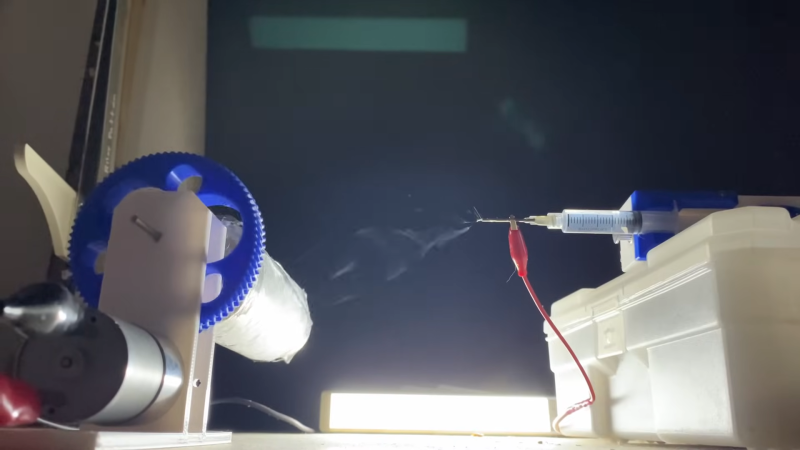When you think about additive manufacturing, thoughts naturally turn to that hot-glue squirting CNC machine sitting on your bench and squeezing whatever plastic doodad you need. But 3D printing isn’t the only way to build polymer structures, as [Riley] shows us with this fascinating attempt to create electrospun heart valves.
Now, you may never have heard of electrospinning, but we’ll venture a guess that as soon as you see what it entails, you’ll have a “Why didn’t I think of that?” moment. As [Riley] explains, electrospinning uses an electric field to build structures from fine threads of liquid polymer solution — he uses polycaprolactone (PCL), a biodegradable polyester we’ve seen used in other medical applications, which he dissolves in acetone. He loads it into a syringe, attaches the positive terminal of a high-voltage power supply to the hypodermic needle, and the negative terminal to a sheet of aluminum foil. The charge turns the PCL droplets into fine threads that accumulate on the foil; once the solvent flashes off, what’s left is a gossamer layer of non-woven plastic fabric.
To explore the uses of this material, [Riley] chose to make an artificial heart valve. This required a 3D-printed framework with three prongs, painted with conductive paint. He tried a few variations on the design before settling on a two-piece armature affixed to a rotating shaft. The PCL accumulates on the form, creating a one-piece structure that can be gingerly slipped off thanks to a little silicon grease used as a release agent.
The results are pretty impressive. The structure bears a strong resemblance to an artificial tricuspid heart valve, with three delicate leaves suspended between the upright prongs. It’s just a proof of concept, of course, but it’s a great demonstration of the potential of electrospinning, as well as an eye-opening look at what else additive manufacturing has to offer.

















Try adding a draft angle to help with releasing the mould.
Repurpose a halfway modern automotive paint gun.
You are on step 1 of reinventing it, starting with the most recent change, the electric field.
You’ll get a much evener coating.
Let you concentrate on the target.
A Paint gun is not a bad way to get a larger area at once but the intent is not to concentrate the spray. You need the charge to pull the fibers out.
So with a paint gun you could spray under the target and then pull back up to the anode. Could produce a more even coat over a larger area.
The first part of this video makes it sound like the intent of using a super thin cloth is to let you then print a tissue on top. In which case you should polish the print add a copper or brass coat (which he is pretty well set to do with electro plating) then polish more.
Wow! This is wicked awesome! Thanks so much for writing this article! Next video, planning to test the heart valve in a hydrodynamic flow cell
I love his video. Riley is creative! The effortless hauling out of high end equipment and then the taking away of the equipment, all in that wooden low tech lab with a cat. And then the use of the black paper drawings. Amazing.
So for work, some coworkers were experimenting with different conductive spray paints, essentially the silvery colors from common hardware stores and also sprinkling conductive powder essentially graphite powder lubricant also from common hardware stores onto the the still wet sprayed parts and were able to generate impressive wave guide and faraday cage properties for unique geometries. I bet if something similar was tried and then coated with a spray clear coat or another silver coat similar to the technique used for sandpaperless smoothing of 3d printed models, it would end up with a more uniform coating while also reducing the polymer adherence
It would have been nice to see it acting as a valve, maybe just sucking and blowing air throught it
Awesome. Pure inventor spirit.
Awesome video, learned a lot.
Any thought to using conductive PLA for 3d print vs conductive paint? Might help with the adherence problem if the glue is the culprit.
Also angling the pillars towards the center (rather than 90 degrees) may help get the leaflets to meet closer to the center, and prevent regurgitating through the valve (which can damage cells).
Appreciated the neat way to make tubes- which may simulate blood vessels – you should spin up some of those (wide enough) to test your valve.
Thanks for sharing this!
Actually, there are two modes electro spanning can taken place in: a orderly straight pull of the material out of the nozzle, and onze the field is strong enough, a chaotic stretching and random pooling on the target. I have always wondered if you can somehow steer the fiber with something similar to deflection plates from a crt?